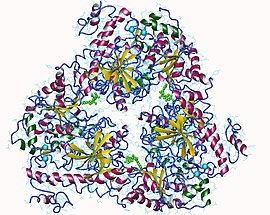Adenylate cyclase
| Adenylyl cyclase | |||||||||
|---|---|---|---|---|---|---|---|---|---|

Adenylate cyclase (calmodulin sensitive) trimer, Bacillus anthracis
Epinephrine binds its receptor, that associates with a heterotrimeric G protein. The G protein associates with adenylyl cyclase, which converts ATP to cAMP, spreading the signal. |
|||||||||
| Identifiers | |||||||||
| EC number | 4.6.1.1 | ||||||||
| CAS number | 9012-42-4 | ||||||||
| Databases | |||||||||
| IntEnz | IntEnz view | ||||||||
| BRENDA | BRENDA entry | ||||||||
| ExPASy | NiceZyme view | ||||||||
| KEGG | KEGG entry | ||||||||
| MetaCyc | metabolic pathway | ||||||||
| PRIAM | profile | ||||||||
| PDB structures | RCSB PDB PDBe PDBsum | ||||||||
| Gene Ontology | AmiGO / EGO | ||||||||
|
|||||||||
| Search | |
|---|---|
| PMC | articles |
| PubMed | articles |
| NCBI | proteins |
Adenylyl cyclase (EC 4.6.1.1, also commonly known as adenyl cyclase and adenylate cyclase, abbreviated AC) is an enzyme with key regulatory roles in essentially all cells. It is the most polyphyletic known enzyme: six distinct classes have been described, all catalyzing the same reaction but representing unrelated gene families with no known sequence or structural homology. The best known class of adenylyl cyclases is class III or AC-III (Roman numerals are used for classes). AC-III occurs widely in eukaryotes and has important roles in many human tissues.
All classes of adenylyl cyclases catalyse the conversion of adenosine triphosphate (ATP) to 3',5'-cyclic AMP (cAMP) and pyrophosphate. Magnesium ions are generally required and appears to be closely involved in the enzymatic mechanism. The cAMP produced by AC then serves as a regulatory signal via specific cAMP-binding proteins, either transcription factors, enzymes (e.g., cAMP-dependent kinases), or ion transporters.
The first class of adenylyl cyclases occur in many bacteria including E. coli. This was the first class of AC to be characterized. It was observed that E. coli deprived of glucose produce cAMP that serves as an internal signal to activate expression of genes for importing and metabolizing other sugars. cAMP exerts this effect by binding the transcription factor CRP, also known as CAP. Class I AC's are large cytosolic enzymes (~100 kDa) with a large regulatory domain (~50 kDa) that indirectly senses glucose levels. As of 2012[update], no crystal structure is available for class I AC.
...
Wikipedia
